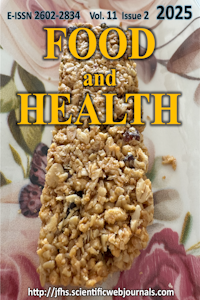Kahvaltılık margarinlerin üretiminde meydana gelen fiziko-kimyasal değişimlerin beslenme ve sağlık acısından değerlendirilmesi
Abstract
Bu çalışmada, yemeklik bitkisel kahvaltılık margarinlerin üretiminde uygulanan hidrojenasyon, interesterifikasyon ve fraksiyonel kristalizasyon gibi modifikasyon tekniklerinin margarinlerin fiziksel yapısında ve kimyasal bileşiminde meydana getirdiği değişimlerin beslenme, sağlık, gıda güvenliği acısından değerlendirilmiştir. Bu kapsamda kahvaltılık margarin örneklerinin iyot sayısı, toplam polar bileşikler (TPC), erime noktası, yağ asitleri ve sterol kompozisyonları incelenmiştir. İncelenen örneklerde iyot sayısı 69.33 ±0.58 ile 75.33 ±0.58 arasında, erime noktaları 33.00 ±1.04°C ile 36.00 ±1.00°C arasında değiştiği belirlenmiştir. Yağ asitleri kompozisyonunda doymamış yağ asitleri ağırlıklı olarak oleik asit (C18:1) (%40.33 ±0.15; %54.30 ±0.20) oluşmakta, bunu linoleik asit (C18:2) (%11.05–26.52) ve linolenik asit (C18:3) (%0.83 – %3.50) izlediği tespit edilmiştir. Sterol kompozisyonunda β-Sitosterol (%60.28 ±0.19; %73.90 ±0.20) en baskın bileşenler olarak tespit edilmiş bunu Kampesterol (%12.30 ±0.33; %27.05 ±0.15), Stigma sterol (%3.82 ±0.18; %11.30 ±0.70), ∆7-stigma sterol (%2.47 ±0.03; %6.00 ±0.50) takip ettiği belirlenmiştir. Sonuç olarak, kahvaltılık margarin örneklerinde toplam polar bileşiklerin Dünya sağlık örgütünün belirlediği üst sınıra yakın olduğu ve omega-3 yağ asidinin oldukça düşük düzeyde olduğu tespit edilmiştir. Bu parametreler kapsamında sağlıklı beslenme ve gıda güvenliği acısından uzun vadede riskler oluşturacağı düşünülmektedir. Kahvaltılık margarinlerin değerlendirilmesinde ilk defa kullanılan bu parametreler sağlıklı beslenme bilicinin gelişmesinde gerek üretici ve gerek tüketiciler arsında farkındalık oluşturulmasına katkıda bulunacaktır.
Ethical Statement
Yazarlar bu çalışmanın insan veya hayvan denekleri içeren deneyleri içermediğini, bu nedenle etik kurul onayı gerekmediğini beyan ederler.
Thanks
Doç. Dr. Mustafa YAMAN ve Uzm. Arş. Ömer Faruk MIZRAK ’a analiz destekleri için teşekkür ederiz.
References
- Ağagündüz, D. (2020). Kızartma Yağlarında Oluşan Polar Maddeler: Oluşum Mekanizmaları ve Sağlık Etkileri. Sağlık Bilimleri Alanında Akademik Çalışmalar—II. Gece Kitaplığı Yayınevi. https://avesis.gazi.edu.tr Alpaslan, M., Karaali, A. (1998). The interesterification-induced changes in olive and palm oil blends. Food Chemistry, 61(3), 301-305. https://doi.org/10.1016/S0308-8146(97)00081-2
- ANON (1988). T.S.E. 2812 Revizyon Metodu. Kapiller tüp yöntemi. Kayma (erime ) Noktası Tayini
- AOCS (1986). Official Methods and Recommended Practice of the American Oil Chemists Society. 3th Edition. Volum1. Illinois- USA
- Arıcı M., Taşan, M., Geçgel, Ü., & Özsoy, S. (2002). Determination of fatty acid composition and total trans fatty acids of Turkish margarines by Capillary Gas-Liquid Chromatography. Journal of American Oil Chemists’ Society, 79, 439-441. https://doi.org/10.1007/s11746-002-0502-x
- Baker, E.J., Miles, E.A., Burdge, G.C., Yaqoob, P., Calder, P.C. (2016). Metabolism and functional effects of plant-derived omega-3 fatty acids in humans. Progress in Lipid Research, 64, 30-56. https://doi.org/10.1016/j.plipres.2016.07.002
- Burlingame, B., Nishida, C., Uauy, R., Weisell, R. (2009). Fats and Fatty Acids in Human Nutrition: Introduction. Annuals of Nutrition & Metabolism, 55, 5-7. https://doi.org/10.1159/000228993
- Baysal, A. (1996). Trans yağ asitleri ve kroner kalp hastalığı riski. Beslenme ve Diyet Dergisi, 25( 2), 1-4.
- Beltrán, M., Ruiz De Adana, M.S., Tinahones, F., Gómez-Zumaquero, J.M., García-Fuentes, E., González-Romero, S. (2003). Hypertension is related to the degradation of dietary frying oils. The American Journal of Clinical Nutrition, 78(6), 1092-1097. https://doi.org/10.1093/ajcn/78.6.1092
- Bishehkolaei, M., & Pathak, Y. (2024). Influence of omega n-6/n-3 ratio on cardiovascular disease and nutritional interventions. Human Nutrition & Metabolism, 37, 200275. https://doi.org/10.1016/j.hnm.2024.200275
- Can, N. (2019). Bitkisel yağların muhafazasında oksidatif stabilitenin önemi ve oksidatif stabilitenin belirlenmesinde kullanılan analiz yöntemleri. ABMYO Dergisi, 54, 107-124.
- Çakmakcı, S. & Kahyaoğlu, T.D. (2012). Yağ asitlerinin sağlık ve beslenme üzerine etkilerine genel bir bakış. Akademik Gıda, 10(1), 103-113.
- Dobarganes, M.C., Márquez-Ruiz, G. (2007). Chapter 6-Formation and Analysis of Oxidized Monomeric, Dimeric, and Higher Oligomeric Triglycerides. M.D. Erickson (Ed.), Deep Frying (Second Edition) s, 87-110). AOCS Press. https://doi.org/10.1016/B978-1-893997-92-9.50012-8
- Ergönül, P.G. (2013). Solid fat contents and instrumental textural attributes of margarines sold in Turkish market. Quality Assurance and Safety of Crops & Foods, 5(2), 157-161. https://doi.org/10.3920/QAS2012.0122
- Glueck, C.J., Speirs, J., Tracy, T., Streicher, P., Illig, E., Vandegrift, J. (1991). Relationships of serum plant sterols (phytosterols) and cholesterol in 595 hypercholesterolemic subjects, and familial aggregation of phytosterols, cholesterol, and premature coronary heart disease in hyperphytosterolemic probands and their first-degree relatives. Metabolism, 40(8), 842-848. https://doi.org/10.1016/0026-0495(91)90013-M
- Gomes, T., Caponio, F., Durante, V., Summo, C., Paradiso, V.M. (2012). The amounts of oxidized and oligopolymeric triacylglycerols in refined olive oil as a function of crude oil oxidative level. LWT-Food Science and Technology, 45(2), 186-190. https://doi.org/10.1016/j.lwt.2011.07.008
- Grootveld, M., Percival, B.C., Leenders, J., Wilson, P.B. (2020). Potential adverse public health effects afforded by the ingestion of dietary lipid oxidation product toxins: Significance of fried food sources. Nutrients, 12(4), 974. https://doi.org/10.3390/nu12040974
- Hashempour-Baltork, F., Torbati, M., Azadmard-Damirchi, S., Savage, G.P. (2016). Vegetable oil blending: A review of physicochemical, nutritional and health effects. Trends in Food Science & Technology, 57, 52-58. https://doi.org/10.1016/j.tifs.2016.09.007
- IUPAC (1992). International Union of Pure and Applied Chemistry Applied Chemistry Division Commission on Oils, Fats and Derivatives. 1St Supplement to the 7th Revised and Enlarged Edition.
- IUPAC (1987). International Union of Pure and Applied Chemistry Applied Chemistry Division Commission on Oils, Fats and Derivatives. 1St Supplement to the 7th Revised and Enlarged Edition.
- Jones, P.J.H & Suhad, S Abu Mweis, S.S. (2009). Phytosterols as functional food ingredients: linkages to cardiovascular disease and cancer. Current Opinion in Clinical Nutrition and Metabolic Care, 12(2),147-151. https://doi.org/10.1097/MCO.0b013e328326770f
- Jiméneza, P., Bustamantea, A., Echeverríab, F., Sambraa, V., Rincón-Cerverac, M.A. Faríasa, C., & Valenzuela, R. (2024). Metabolic benefits of phytosterols: Chemical, nutritional, and functional aspects. Food Reviews International, 40(9), 2917–2939. https://doi.org/10.1080/87559129.2023.2290489 Laakso, P. (2005). Analysis of sterols from various food matrices. European Journal of Lipid Science and Technology, 107, 402410. https://doi.org/10.1002/ejlt.200501134
- Li, J., Li, X., Cai, W., Liu, Y. (2016). Comparison of different polar compounds-induced cytotoxicity in human hepatocellular carcinoma HepG2 cells. Lipids in Health and Disease, 15, 30. https://doi.org/10.1186/s12944-016-0201-z
- Márquez-Ruiz, G. (2009). Determination of polar compounds in used frying oils and fats by adsorption chromatography. AOCS lipid library. https://www.aocs.org/resource/determination-of-polar-compounds-in-used-frying-oils-and-fats-by-adsorption-chromatography/
- Quilez, J., GarcIa-Lorda, P., Salas-Salvadó, J. (2003). Potential uses and benefits of phytosterols in diet: Present situation and future directions. Clinical Nutrition, 22(4), 343-351. https://doi.org/10.1016/s0261-5614(03)00060-8
- Oteng, A.B.& Kersten, S. (2020). Mechanisms of action of trans fatty acids. Advances in Nutirition, 11(3), 697-708. https://doi.org/10.1093/advances/nmz125
- Senanayake, S.P.J.N., Shahidi, F. (2020). Modification of Fats and Oils via Chemical and Enzymatic Methods. Içinde F. Shahidi (Ed.), Bailey’s Industrial Oil and Fat Products (1. bs, ss. 1-29). Wiley. https://doi.org/10.1002/047167849X.bio062.pub2
- Tolve, R., Cela, N., Condelli, N., Di Cairano, M., Caruso, M.C., & Galgano, F. (2020). Microencapsulation as a tool for the formulation of functional foods: The Phytosterols’ case study. Foods, 9(4), 470. https://doi.org/10.3390/foods9040470
- Simopoulos, A.P. (1998). The return of ώ-3 fatty acids into the food supply: Land-based animal food products and their health effects. Karger Medical and Scientific Publishers. https://doi.org/10.1159/isbn.978-3-318-00310-9
- Simopoulos, A.P. (2002). The importance of the ratio of omega-6/omega-3 essential fatty acids. Biomedicine & Pharmacotherapy, 56(8), 365-379. https://doi.org/10.1016/S0753-3322(02)00253-6
- Soriguer, F., Rojo-Martínez, G., Dobarganes, M.C., García Almeida, J.M., Esteva, I., Soupas, L. (2006). Oxidative stability of phytosterols in food models and foods. EKT-series 1370. University of Helsinki. Department of Applied Chemistry and Microbiology. p, 110 + 58. Taşan, M. (2008). Fitosterollerin insan beslenmesindeki yeri ve sağlığa etkileri. Türkiye 10. Gıda Kongresi, 21-23.
- Taşan, M., Bilgin, B., Geçgel, Ü., Demirci, A. (2006). Phytosterols as functional food ingredients. Tekirdağ Ziraat Fakültesi Dergisi, 3(2), 153-159.
- Taşan, M., Dağlıoğlu, O. (2005). Trans yağ asitlerinin yapısı, oluşumu ve gıdalarla alınması. Tekirdağ Ziraat Fakültesi Dergisi, 2(1), Article 1.
- Tetik, N., Erbaş, M., Turhan, İ. (2007). Fonksiyonel gıda bileşeni olarak fitosteroller. Gıda, 32(6), Article 6.
- Timms, R.E. (2005). Fractional crystallisation-The fat modification process for the 21st century. European Journal of Lipid Science and Technology, 107(1), 48-57. https://doi.org/10.1002/ejlt.200401075
- Yuan, L., Jiang, F., Cao, X., Liu, Y., Xu, Y.-J. (2020). Metabolomics reveals the toxicological effects of polar compounds from frying palm oil. Food & Function, 11(2), 1611-1623. https://doi.org/10.1039/C9FO02728A
- Yıldız, M. (1996). Margarin üretiminde yeni bir teknoloji: İnteresterifikasyon. Gıda Teknolojisi. 5, 56-62.
Evaluation of physico-chemical changes in the production of breakfast margarines in terms of nutrition and health
Abstract
In this study, the changes in the physical structure and chemical composition of margarine caused by modification techniques such as hydrogenation, interesterification and fractional crystallisation applied in the production of edible vegetable breakfast margarine were evaluated in terms of nutrition, health and food safety. In this context, iodine number, total polar compounds (TPC), melting point, fatty acid and sterol compositions of breakfast margarine samples were analysed. It was determined that the iodine number ranged between 69.33 ±0.58 and 75.33 ±0.58, and the melting points ranged between 33.00 ±1.04°C and 36.00 ±1.00°C. In the fatty acid composition, unsaturated fatty acids are mainly oleic acid (C18:1) (40.33 ±0.15%; 54.30% ±0.20%), followed by linoleic acid (C18:2) (11.05-26.52%) and linolenic acid (C18:3) (0.83-3.50%). In sterol composition, β-Sitosterol (60.28 ±0.19%; 73.90 ±0.20%) was the most dominant component followed by Campesterol (12.30 ±0.33%; 27.05 ±0.15%), Stigma sterol (3.82 ±0.18 %; 11.30 ±0.70 %), ∆7-stigma sterol (2.47 ±0.03 %; 6.00 ±0.50%). In conclusion, it was determined that total polar compounds in breakfast margarine samples were close to the upper limit determined by the World Health Organisation, and omega-3 fatty acids were very low. Within the scope of these parameters, it is thought to pose long-term risks regarding healthy nutrition and food safety. These parameters, which are used for the first time in the evaluation of breakfast margarine, will contribute to the development of healthy nutrition scientists and raise awareness among producers and consumers.
Ethical Statement
The authors declare that this study does not include experiments with human or animal subjects, so ethics committee approval is not required.
Thanks
We would like to thank Assoc. Prof. Dr. Mustafa YAMAN and Spec. Res. Ömer Faruk MIZRAK for their analysis support.
References
- Ağagündüz, D. (2020). Kızartma Yağlarında Oluşan Polar Maddeler: Oluşum Mekanizmaları ve Sağlık Etkileri. Sağlık Bilimleri Alanında Akademik Çalışmalar—II. Gece Kitaplığı Yayınevi. https://avesis.gazi.edu.tr Alpaslan, M., Karaali, A. (1998). The interesterification-induced changes in olive and palm oil blends. Food Chemistry, 61(3), 301-305. https://doi.org/10.1016/S0308-8146(97)00081-2
- ANON (1988). T.S.E. 2812 Revizyon Metodu. Kapiller tüp yöntemi. Kayma (erime ) Noktası Tayini
- AOCS (1986). Official Methods and Recommended Practice of the American Oil Chemists Society. 3th Edition. Volum1. Illinois- USA
- Arıcı M., Taşan, M., Geçgel, Ü., & Özsoy, S. (2002). Determination of fatty acid composition and total trans fatty acids of Turkish margarines by Capillary Gas-Liquid Chromatography. Journal of American Oil Chemists’ Society, 79, 439-441. https://doi.org/10.1007/s11746-002-0502-x
- Baker, E.J., Miles, E.A., Burdge, G.C., Yaqoob, P., Calder, P.C. (2016). Metabolism and functional effects of plant-derived omega-3 fatty acids in humans. Progress in Lipid Research, 64, 30-56. https://doi.org/10.1016/j.plipres.2016.07.002
- Burlingame, B., Nishida, C., Uauy, R., Weisell, R. (2009). Fats and Fatty Acids in Human Nutrition: Introduction. Annuals of Nutrition & Metabolism, 55, 5-7. https://doi.org/10.1159/000228993
- Baysal, A. (1996). Trans yağ asitleri ve kroner kalp hastalığı riski. Beslenme ve Diyet Dergisi, 25( 2), 1-4.
- Beltrán, M., Ruiz De Adana, M.S., Tinahones, F., Gómez-Zumaquero, J.M., García-Fuentes, E., González-Romero, S. (2003). Hypertension is related to the degradation of dietary frying oils. The American Journal of Clinical Nutrition, 78(6), 1092-1097. https://doi.org/10.1093/ajcn/78.6.1092
- Bishehkolaei, M., & Pathak, Y. (2024). Influence of omega n-6/n-3 ratio on cardiovascular disease and nutritional interventions. Human Nutrition & Metabolism, 37, 200275. https://doi.org/10.1016/j.hnm.2024.200275
- Can, N. (2019). Bitkisel yağların muhafazasında oksidatif stabilitenin önemi ve oksidatif stabilitenin belirlenmesinde kullanılan analiz yöntemleri. ABMYO Dergisi, 54, 107-124.
- Çakmakcı, S. & Kahyaoğlu, T.D. (2012). Yağ asitlerinin sağlık ve beslenme üzerine etkilerine genel bir bakış. Akademik Gıda, 10(1), 103-113.
- Dobarganes, M.C., Márquez-Ruiz, G. (2007). Chapter 6-Formation and Analysis of Oxidized Monomeric, Dimeric, and Higher Oligomeric Triglycerides. M.D. Erickson (Ed.), Deep Frying (Second Edition) s, 87-110). AOCS Press. https://doi.org/10.1016/B978-1-893997-92-9.50012-8
- Ergönül, P.G. (2013). Solid fat contents and instrumental textural attributes of margarines sold in Turkish market. Quality Assurance and Safety of Crops & Foods, 5(2), 157-161. https://doi.org/10.3920/QAS2012.0122
- Glueck, C.J., Speirs, J., Tracy, T., Streicher, P., Illig, E., Vandegrift, J. (1991). Relationships of serum plant sterols (phytosterols) and cholesterol in 595 hypercholesterolemic subjects, and familial aggregation of phytosterols, cholesterol, and premature coronary heart disease in hyperphytosterolemic probands and their first-degree relatives. Metabolism, 40(8), 842-848. https://doi.org/10.1016/0026-0495(91)90013-M
- Gomes, T., Caponio, F., Durante, V., Summo, C., Paradiso, V.M. (2012). The amounts of oxidized and oligopolymeric triacylglycerols in refined olive oil as a function of crude oil oxidative level. LWT-Food Science and Technology, 45(2), 186-190. https://doi.org/10.1016/j.lwt.2011.07.008
- Grootveld, M., Percival, B.C., Leenders, J., Wilson, P.B. (2020). Potential adverse public health effects afforded by the ingestion of dietary lipid oxidation product toxins: Significance of fried food sources. Nutrients, 12(4), 974. https://doi.org/10.3390/nu12040974
- Hashempour-Baltork, F., Torbati, M., Azadmard-Damirchi, S., Savage, G.P. (2016). Vegetable oil blending: A review of physicochemical, nutritional and health effects. Trends in Food Science & Technology, 57, 52-58. https://doi.org/10.1016/j.tifs.2016.09.007
- IUPAC (1992). International Union of Pure and Applied Chemistry Applied Chemistry Division Commission on Oils, Fats and Derivatives. 1St Supplement to the 7th Revised and Enlarged Edition.
- IUPAC (1987). International Union of Pure and Applied Chemistry Applied Chemistry Division Commission on Oils, Fats and Derivatives. 1St Supplement to the 7th Revised and Enlarged Edition.
- Jones, P.J.H & Suhad, S Abu Mweis, S.S. (2009). Phytosterols as functional food ingredients: linkages to cardiovascular disease and cancer. Current Opinion in Clinical Nutrition and Metabolic Care, 12(2),147-151. https://doi.org/10.1097/MCO.0b013e328326770f
- Jiméneza, P., Bustamantea, A., Echeverríab, F., Sambraa, V., Rincón-Cerverac, M.A. Faríasa, C., & Valenzuela, R. (2024). Metabolic benefits of phytosterols: Chemical, nutritional, and functional aspects. Food Reviews International, 40(9), 2917–2939. https://doi.org/10.1080/87559129.2023.2290489 Laakso, P. (2005). Analysis of sterols from various food matrices. European Journal of Lipid Science and Technology, 107, 402410. https://doi.org/10.1002/ejlt.200501134
- Li, J., Li, X., Cai, W., Liu, Y. (2016). Comparison of different polar compounds-induced cytotoxicity in human hepatocellular carcinoma HepG2 cells. Lipids in Health and Disease, 15, 30. https://doi.org/10.1186/s12944-016-0201-z
- Márquez-Ruiz, G. (2009). Determination of polar compounds in used frying oils and fats by adsorption chromatography. AOCS lipid library. https://www.aocs.org/resource/determination-of-polar-compounds-in-used-frying-oils-and-fats-by-adsorption-chromatography/
- Quilez, J., GarcIa-Lorda, P., Salas-Salvadó, J. (2003). Potential uses and benefits of phytosterols in diet: Present situation and future directions. Clinical Nutrition, 22(4), 343-351. https://doi.org/10.1016/s0261-5614(03)00060-8
- Oteng, A.B.& Kersten, S. (2020). Mechanisms of action of trans fatty acids. Advances in Nutirition, 11(3), 697-708. https://doi.org/10.1093/advances/nmz125
- Senanayake, S.P.J.N., Shahidi, F. (2020). Modification of Fats and Oils via Chemical and Enzymatic Methods. Içinde F. Shahidi (Ed.), Bailey’s Industrial Oil and Fat Products (1. bs, ss. 1-29). Wiley. https://doi.org/10.1002/047167849X.bio062.pub2
- Tolve, R., Cela, N., Condelli, N., Di Cairano, M., Caruso, M.C., & Galgano, F. (2020). Microencapsulation as a tool for the formulation of functional foods: The Phytosterols’ case study. Foods, 9(4), 470. https://doi.org/10.3390/foods9040470
- Simopoulos, A.P. (1998). The return of ώ-3 fatty acids into the food supply: Land-based animal food products and their health effects. Karger Medical and Scientific Publishers. https://doi.org/10.1159/isbn.978-3-318-00310-9
- Simopoulos, A.P. (2002). The importance of the ratio of omega-6/omega-3 essential fatty acids. Biomedicine & Pharmacotherapy, 56(8), 365-379. https://doi.org/10.1016/S0753-3322(02)00253-6
- Soriguer, F., Rojo-Martínez, G., Dobarganes, M.C., García Almeida, J.M., Esteva, I., Soupas, L. (2006). Oxidative stability of phytosterols in food models and foods. EKT-series 1370. University of Helsinki. Department of Applied Chemistry and Microbiology. p, 110 + 58. Taşan, M. (2008). Fitosterollerin insan beslenmesindeki yeri ve sağlığa etkileri. Türkiye 10. Gıda Kongresi, 21-23.
- Taşan, M., Bilgin, B., Geçgel, Ü., Demirci, A. (2006). Phytosterols as functional food ingredients. Tekirdağ Ziraat Fakültesi Dergisi, 3(2), 153-159.
- Taşan, M., Dağlıoğlu, O. (2005). Trans yağ asitlerinin yapısı, oluşumu ve gıdalarla alınması. Tekirdağ Ziraat Fakültesi Dergisi, 2(1), Article 1.
- Tetik, N., Erbaş, M., Turhan, İ. (2007). Fonksiyonel gıda bileşeni olarak fitosteroller. Gıda, 32(6), Article 6.
- Timms, R.E. (2005). Fractional crystallisation-The fat modification process for the 21st century. European Journal of Lipid Science and Technology, 107(1), 48-57. https://doi.org/10.1002/ejlt.200401075
- Yuan, L., Jiang, F., Cao, X., Liu, Y., Xu, Y.-J. (2020). Metabolomics reveals the toxicological effects of polar compounds from frying palm oil. Food & Function, 11(2), 1611-1623. https://doi.org/10.1039/C9FO02728A
- Yıldız, M. (1996). Margarin üretiminde yeni bir teknoloji: İnteresterifikasyon. Gıda Teknolojisi. 5, 56-62.
Details
| Primary Language | Turkish |
|---|---|
| Subjects | Oil Technology |
| Journal Section | Research Article |
| Authors | |
| Early Pub Date | March 20, 2025 |
| Publication Date | March 28, 2025 |
| Submission Date | January 30, 2025 |
| Acceptance Date | March 5, 2025 |
| Published in Issue | Year 2025 Volume: 11 Issue: 2 |
Journal is licensed under a
CreativeCommons Attribtion-ShareAlike 4.0 International Licence 


Diamond Open Access refers to a scholarly publication model in which journals and platforms do not charge fees to either authors or readers.
Open Access Statement:
This is an open access journal which means that all content is freely available without charge to the user or his/her institution. Users are allowed to read, download, copy, distribute, print, search, or link to the full texts of the articles, or use them for any other lawful purpose, without asking prior permission from the publisher or the author. This is in accordance with the BOAI definition of open access.
Archiving Policy:
Archiving is done according to ULAKBİM "DergiPark" publication policy (LOCKSS).

